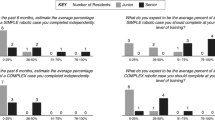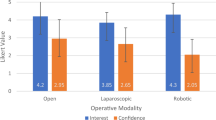Abstract
Introduction
Trainees underestimate the amount of operative autonomy they receive, whereas faculty overestimate; this has not been studied in robotics. We aimed to assess the perceptions and expectations of our general surgery trainees and faculty on robotic console participation in academic surgery.
Methods
A survey was administered to general surgery robotic faculty and trainees eligible to sit at the console. Participants estimated the average percentage of trainee console participation time (CPT) per case for robotic cholecystectomies (CCY) and inguinal hernia repairs (IHR) from January to June 2019. Trainees were additionally asked what CPT they expected according to their training level (novice or senior). Expected CPTs were compared to actual CPTs extracted from robotic console logs during the same time frame.
Results
Survey response rate was 80% for faculty (4 of 5) and 65% for trainees (15 of 23). Novices expected a higher CPT than they perceived in CCY (42.8% ± 14.8% vs 19.0% ± 17.2%, p = 0.03) and IHR (36.1% ± 17.6% vs. 10.7% ± 13.7%, p = 0.01), but in actuality, they did more CPT than perceived (by 34.9% in CCY, p < 0.01; 14% in IHR, p = 0.10). Senior trainees accurately perceived their CPT in IHR, but expected a higher CPT by 15.9% (p = 0.04). In CCY, seniors perceived a 23.8% higher CPT than in reality (p = 0.04). Faculty generally overperceived trainee CPT by 12.8–16.3% (p > 0.05). Compared to faculty, novices perceived lower CPTs in both CCY by 29.9% (p = 0.16) and IHR by 26.8% (p = 0.07), but seniors tended to agree with the faculty-perceived CPTs (p > 0.05).
Conclusion
Our robotic trainees expect to do more on the console than they perceive. Faculty think they allow their trainees more participation than in reality. Compared to faculty perception, novice trainees perceive a much lower level of trainee participation than senior trainees do. Expectation setting and standardizing learning curves are important for robotic surgery training.


Similar content being viewed by others
References
Intuitive Surgical, Inc. (2018) Annual Report. Sunnyvale, CA. https://www.annualreports.com/HostedData/AnnualReportArchive/i/NASDAQ_ISRG_2018.pdf
Carpenter BT, Sundaram CP (2017) Training the next generation of surgeons in robotic surgery. Robot Surg 4:39–44
Tom CM, Maciel JD, Korn A, Ozao-Choy JJ, Hari DM, Neville AL, de Virgilio C, Dauphine C (2019) A survey of robotic surgery training curricula in general surgery residency programs: how close are we to a standardized curriculum? Am J Surg 217:256–260
Zhao B, Lam J, Hollandsworth HM, Lee AM, Lopez NE, Abbadessa B, Eisenstein S, Cosman BC, Ramamoorthy SL, Parry LA (2019) General surgery training in the era of robotic surgery: a qualitative analysis of perceptions from resident and attending surgeons. Surg Endosc. https://doi.org/10.1007/s00464-019-06954-0
Farivar BS, Flannagan M, Leitman IM (2015) General surgery residents' perception of robot-assisted procedures during surgical training. J Surg Educ 72:235–242
Sandhu G, Magas CP, Robinson AB, Scally CP, Minter RM (2017) Progressive entrustment to achieve resident autonomy in the operating room: a national qualitative study with general surgery faculty and residents. Ann Surg 265:1134–1140
Hanly EJ, Miller BE, Kumar R, Hasser CJ, Coste-Maniere E, Talamini MA, Aurora AA, Schenkman NS, Marohn MR (2006) Mentoring console improves collaboration and teaching in surgical robotics. J Laparoendosc Adv Surg Tech A 16:445–451
Williams RG, George BC, Meyerson SL, Bohnen JD, Dunnington GL, Schuller MC, Torbeck L, Mullen JT, Auyang E, Chipman JG, Choi J, Choti M, Endean E, Foley EF, Mandell S, Meier A, Smink DS, Terhune KP, Wise P, DaRosa D, Soper N, Zwischenberger JB, Lillemoe KD, Fryer JP, Procedural L, Safety C (2017) What factors influence attending surgeon decisions about resident autonomy in the operating room? Surg 162:1314–1319
Meyerson SL, Sternbach JM, Zwischenberger JB, Bender EM (2017) Resident autonomy in the operating room: expectations versus reality. Ann Thorac Surg 104:1062–1068
Meyerson SL, Teitelbaum EN, George BC, Schuller MC, DaRosa DA, Fryer JP (2014) Defining the autonomy gap: when expectations do not meet reality in the operating room. J Surg Educ 71:e64–e72
Author information
Authors and Affiliations
Corresponding author
Ethics declarations
Disclosures
Dr. Wang, Ms. Pieper, Mr. Gupta, Ms. Chen, and Drs. Husain and Meara declare that they have no conflicts of interest or financial ties to disclose.
Additional information
Publisher's Note
Springer Nature remains neutral with regard to jurisdictional claims in published maps and institutional affiliations.
Rights and permissions
About this article
Cite this article
Wang, V.L., Pieper, H., Gupta, A. et al. Expectations versus reality: trainee participation on the robotic console in academic surgery. Surg Endosc 35, 4805–4810 (2021). https://doi.org/10.1007/s00464-020-07874-0
Received:
Accepted:
Published:
Issue Date:
DOI: https://doi.org/10.1007/s00464-020-07874-0




